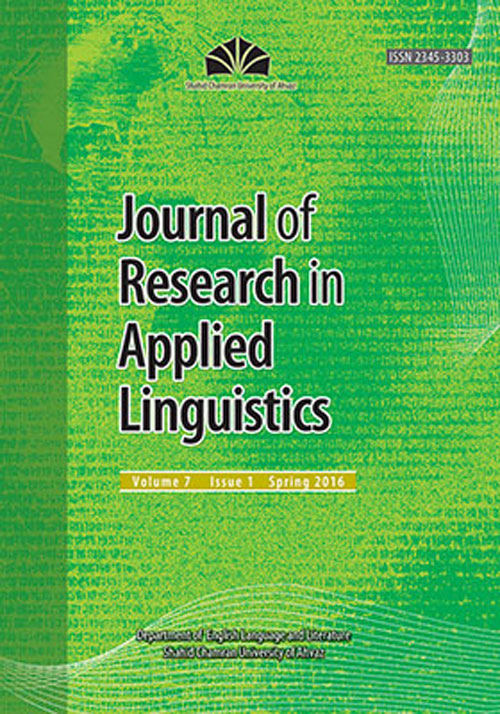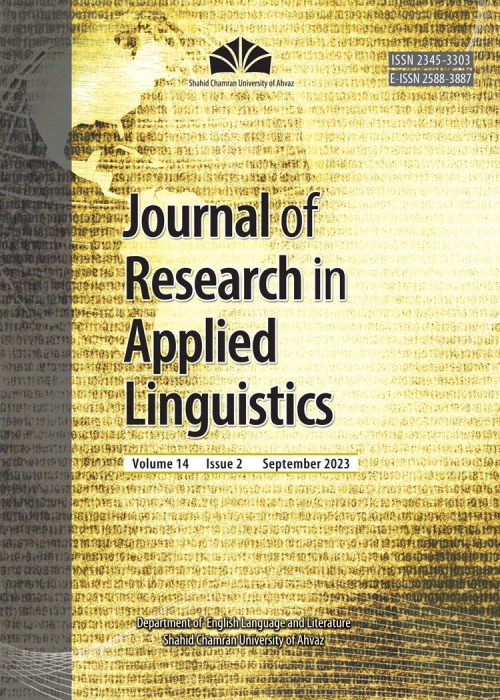فهرست مطالب

Journal of Research in Applied Linguistics
Volume:8 Issue: 1, Spring 2017
- تاریخ انتشار: 1395/12/10
- تعداد عناوین: 9
-
-
Pages 3-21This study aims to offer a critical analysis of V. S. Naipauls second Islamic travelogue Beyond Belief: Islamic Excursions Among the Converted Peoples (1998), which chronicles the authors excursions to the 4 non-Arab Muslim countries of Indonesia, Iran, Pakistan, and Malaysia. This critique is presented, firstly, through problematizing the authors theorization on the theme of Muslim conversion which, according to Naipaul, has bred nothing but neurosis and nihilism in Muslim societiesand then through analyzing representations of the post-Revolutionary Iran of the late 90s. We argue that Naipauls representations fall within an Orientalist frame of reference in which Iran and its people are portrayed through various tropes of Othering in a narrative fraught with disinformation, exaggerations, and reductive treatment of complex sociopolitical phenomena. Finally, Naipauls reasoning in formulating conversion coupled with his myopic approach undermine the authenticity of his representations, resulting in what Said (1998) has dubbed an intellectual catastrophe of the first order (p. 42).Keywords: Orientalism, Naipaul, Iran, Islam, Conversion
-
Pages 22-45The sociocultural theory holds the idea that knowledge to be acquired should be mediated. It underscores the presence of mediation as a crucial factor in internalization of abilities. Given this, the present research was an attempt to examine the effect of mediation on learners reading comprehension strategy in light of 2 approaches of response-based (RB) mediation (Vygotsky) and task-based (TB) mediation (Bruner) to intervention. To this end, the Reading section of the First Certificate in English (2010) and 1 cognitive and metacognitive questionnaire (Phakiti, 2003) were administered to 104 Iranian lower-intermediate EFL learners who were selected by convenience sampling. The questionnaire was given to the participants before and after the mediation session. MANOVA results revealed that not only had the learners monitoring metacognitive strategies changed by interventions, but also the participants in the TB mediation group outperformed those in the RB mediation group.Keywords: Mediation, Reading Comprehension Strategies, Response, Based (RB) Mediation, Task, Based (TB) Mediation
-
Pages 46-71The study investigated whether there was any significant generic difference between the Research Questions (RQs) and Method sections of applied linguistics research articles (RAs) published in international and local Iranian journals. Two hundred applied linguistics RAs (100 from each group) were selected from 5 SSCI-indexed international journals and 5 Iranian Scientific-Research (Elmi-Pazhouheshi) ISC-indexed journals. Having analyzed the Introduction and Method sections based on Swales (2004) CARS model and Lims (2006) model, respectively, we found there were no significant differences in the frequency of occurrence of RQs in the Introduction sections, on the one hand, and between the Method sections of both groups of RAs, on the other. However, significant differences were found in the frequency of occurrence of certain moves and steps in both sections. Moreover, the findings of an expert-viewed validated questionnaire indicated that the RQs were of paramount importance to the authors of both groups of RAs.Keywords: Applied Linguistics, Move, Step, Scientific, Research ISC, Indexed (Local) RA, SSCI, Indexed (International) RA
-
Pages 72-78Vivas have multiple functions in academia, but their main goal is completing thesis evaluation. At the heart of this evaluation is a series of criticisms and their responsive turns by which participants talk vivas as institution into being (Heritage, 1997). Turn-taking is one of the many ways vivas are talked into being. This study drew upon conversation analysis to look into the turn allocation mechanism of criticism-response exchanges and their relationship with the notion of preference and dispreference in the context of Iranian English-medium vivas. It further investigated the relationship between turn-taking, preference structure, and the notion of face understood, following Arundale (2010) as the relational connection and separation. Findings and observations suggest a combination of turn preallocation, conciliatory turn negotiation, and adversarial turn competition of dispreference and preference as well as of the interactional achievement of slight connection and considerable separation in the discourse.Keywords: Viva, Turn-Taking, Preference, Face, Institutional Discourse
-
Pages 89-108The present study examined the different levels of (im)politeness strategies in expressing request, apology, and refusal speech acts across intermediate and advanced Iranian EFL learners to identify their attitudinal ratings of their produced structures in terms of pragmatic success and (im)politeness mannerism. A discourse completion test including 2 Likert scales on attitudinal appropriateness and an(im)politeness mannerism test for every item was distributed among 110 participants (10 native and 100 nonnative English speakers), engaging them in addressing the speech acts to interlocutors of lower, equal, and higher social statuses with intimate or strange distance. Results indicated that despite having a high command of English, the learners showed deficiencies in the use of (im)politenessstrategies that may call for the inclusion of such strategies in EFL instruction programs.Keywords: Awareness, Pragmatics, (Im)politeness Strategy, Request, Apology, Refusal, Iranian EFL Learners
-
Pages 109-132Testing holds an important place in the Iranian test-oriented context where the entrance examinations have serious educational and occupational outcomes. This study aimed to explore the potential washback effects of the General English Language Test of the Ph.D. (GELTP) as part of the Ph.D. University Entrance Examination (PUEE) on the humanities and science students perceptions and practices. The study also examined the students language learning needs to examine the correspondence between the test-takers language needs as well as the GELTP requirement and content. To this end, the data were collected through conducting interviews with 16 Ph.D. students and the administration of a questionnaire to 560 students. Results revealed minor differences in the GELTP washback effects across the science and humanities perceptions and practices. Moreover, the findings showed some mismatch between the test-takers language needs and the test content that affected negatively the test washback effects. Findings can have implications for raising the education and assessment authorities awareness to employ the students feedbacks in designing and modifying high-stakes tests.Keywords: Washback, GELTP, Student's Perceptions, Student's Practices, Disciplinary Variations
-
Pages 133-145This study investigated the employment of interactional metadisocurse in English academic articles written by Iranian ESP students. Data consisted of a total of 66 academic articles written in English by nonhumanities and humanities writers. Discussion and Conclusion sections were extracted, and Hylands (2005) taxonomy was borrowed for analysis. The use of hedges, boosters, and attitude markers was compared in the articles. Total number of each metadiscourse marker was counted, and the differences were checked running Mann-Whitney U test. Analysis revealed that there were disciplinary differences in the use of markers by nonhumanities and humanities. Hedges and attitude markers were more frequent in the humanities articles, rather than the nonhumanities articles. Also, the use of hedges and boosters was statistically significant. Pedagogical implications are discussed in light of the empirical data.Keywords: Interactional Metadiscourse, Nonhumanities, Humanities, Discussion, Conclusion Sections
-
Pages 146-164This study was aimed to compare long-term effects of collaborative and individual task planning on Persian-speaking EFL learners writing performance, using Brown and Baileys (1985) rating scale. Therefore, a group of 90 upper-intermediate EFL learners in collaborative task planning, individual task planning, and control groups took part in the study. In the experimental groups, the participants were required to do task planning before attempting the main task. All the participants took a pretest, posttest, and delayed posttest. ANOVA results indicated task planning produced better writing performance in the experimental groups on the posttest and delayed posttest. Furthermore, repeated measures analyses showed both time and group played a part in the efficacy of the treatment. In fact, the participants of the experimental groups continued to retain the effects of task planning. Results provide further support for the sociocultural theories of L2 development, according to which learning can be strengthened interpersonally.Keywords: Task Planning, Collaborative Writing, Sociocultural Theory, EFL Writing
-
Pages 165-168One of the main concerns of scholars working in the field of EAP over the last 2 decades has been raising the awareness of EAP students and publishers of genre conventions in academic journals. In line with the above concern, many studies have aimed at exploring the general characteristics of research articles (RAs) in the field. Among these features, it seems that the generic moves and textuality have drawn the attention of researchers. Therefore, the purpose of this study was twofold: (1) to compare and contrast the Iranian local ESP journals with their international counterparts in terms of the given features by drawing upon existing research, and (2) to develop a more inclusive model for the analysis of moves and lexical cohesion patterns (LCPs) in the Discussion sections of ESP RAs. Results showed that the Discussion sections in the international ESP RAs tended to have a more cyclical evaluative move mechanism compared with their Iranian local counterparts. Findings also revealed that the organizational patterning and use of the LCPs in consolidating the Results sections of the RAs have a dual intrinsic relationship. Translation of such findings provides a better chance for nonnative EAP writers to publish in international journals.Keywords: Move Analysis, Organizational Patterning, Lexical Cohesion Patterns (LCPs), EAP Articles


